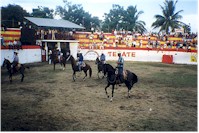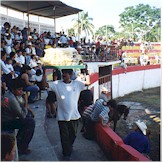 It all started
with cowboys: "Blame it all on my roots...." Garth Brooks said in one of his
most famous songs. And at the root of a popular Mexican
event, called the charreada (rodeo),
is the Mexican cowboy (vaquero). It all started
with cowboys: "Blame it all on my roots...." Garth Brooks said in one of his
most famous songs. And at the root of a popular Mexican
event, called the charreada (rodeo),
is the Mexican cowboy (vaquero).
 Today, a charreada
is the competitive proving ground of a new type of Mexican cowboy, the brave and proud
charro. Originally, Mexican cowboys held contests among themselves to show off
ranching skills such as bronco riding and roping. Now these rodeo showmen have refined
their act so that they provide high quality
entertainment to the rodeo aficionados.
For many North Americans who spend their days in an office at a
desk
or even in a college at a
standing desk, these events represent a male fantasy of showmanship and
even an escape. Today, a charreada
is the competitive proving ground of a new type of Mexican cowboy, the brave and proud
charro. Originally, Mexican cowboys held contests among themselves to show off
ranching skills such as bronco riding and roping. Now these rodeo showmen have refined
their act so that they provide high quality
entertainment to the rodeo aficionados.
For many North Americans who spend their days in an office at a
desk
or even in a college at a
standing desk, these events represent a male fantasy of showmanship and
even an escape.
 A charreada is basically a rodeo, and in Mexico it is a
recognized sport with strict rules to be followed during the competitions. Both men and
women are allowed to compete, wearing colorful costumes trimmed in silver studs. During
intermissions, the horsemen make their mounts dance to a live Mariachi band, while vendors
circulate in the stands selling refreshments and snacks. In the Manzanillo
area, those strict rules are not-so-strict, and the charreadas are loosely
structured, unlike bigger cities. A charreada is basically a rodeo, and in Mexico it is a
recognized sport with strict rules to be followed during the competitions. Both men and
women are allowed to compete, wearing colorful costumes trimmed in silver studs. During
intermissions, the horsemen make their mounts dance to a live Mariachi band, while vendors
circulate in the stands selling refreshments and snacks. In the Manzanillo
area, those strict rules are not-so-strict, and the charreadas are loosely
structured, unlike bigger cities.
 The first vaqueros were Indians or mestizos.
They developed their skills of roping, branding and rounding up cattle in the new Mexican
enterprise of cattle ranching, after the Spanish conquistadors introduced them to horses
and cattle. The mixing of the two cultures created the Mexican cowboy. The first vaqueros were Indians or mestizos.
They developed their skills of roping, branding and rounding up cattle in the new Mexican
enterprise of cattle ranching, after the Spanish conquistadors introduced them to horses
and cattle. The mixing of the two cultures created the Mexican cowboy.
 Charros, or
the horsemen who compete at charreadas, sometimes travel many miles for the
competition. They usually start their training as small children ("charro-ism"
is oftentimes a family tradition), and learn to perform rope tricks and fancy horsemanship
on finely-trained steeds, along with bull riding, bronco riding, and steer roping. The charros
say their sport is living history, an art form developed from actual skills of a life
working on the ranch. Charros, or
the horsemen who compete at charreadas, sometimes travel many miles for the
competition. They usually start their training as small children ("charro-ism"
is oftentimes a family tradition), and learn to perform rope tricks and fancy horsemanship
on finely-trained steeds, along with bull riding, bronco riding, and steer roping. The charros
say their sport is living history, an art form developed from actual skills of a life
working on the ranch.
 Naturally, a charro is a bit "macho"
as tradition demands. After a few belts of tequila before the event, he's ready to face
the risks and the broken bones. A charro is truly a "man's man," who
holds a permanent place among strong horses and tough company. Naturally, a charro is a bit "macho"
as tradition demands. After a few belts of tequila before the event, he's ready to face
the risks and the broken bones. A charro is truly a "man's man," who
holds a permanent place among strong horses and tough company.
 Charros also participate in local parades, and each year hold a
place of honor in the country's September 16 Independence Day parade. Charros are
featured in the first few lines of the Mexican National Anthem, and are honored on Charro
Day, September 14. Charros also participate in local parades, and each year hold a
place of honor in the country's September 16 Independence Day parade. Charros are
featured in the first few lines of the Mexican National Anthem, and are honored on Charro
Day, September 14.
 As one tequila-enriched charro aptly
put it, "We are the warriors of Mexico! Our ancestors fought for our independence and
freedom, and we celebrate our patriotism by being brave and strong charros!" As one tequila-enriched charro aptly
put it, "We are the warriors of Mexico! Our ancestors fought for our independence and
freedom, and we celebrate our patriotism by being brave and strong charros!"
 Locally, charros often
invite seņoritas from the stands to ride one of the dancing steeds, a real
thrill for this author! Locally, charros often
invite seņoritas from the stands to ride one of the dancing steeds, a real
thrill for this author!
Susan Dearing is the author of more than 90 articles about Manzanillo and
the state of Colima. Her
guidebook has
even more information and is in its 15th year of publishing. |